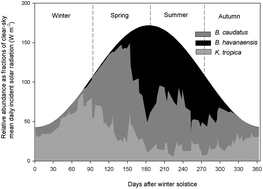Rotifer dynamics in three shallow lakes from the Salado river watershed (Argentina): the potential modulating role of incident solar radiation†
Abstract
In turbid Pampean lakes, incident solar radiation is a major driver of plankton seasonal dynamics. Higher light availability in summer translates into higher primary production, and therefore more food for zooplankton grazers. However, experimental evidence suggests that food produced under the high irradiance conditions prevailing in summer are less suitable to sustain rotifer population growth than that produced under the lower irradiance conditions typical of winter. Here, we analysed time series datasets corresponding to three shallow lakes from the Salado river watershed. This analysis provided evidence for similar seasonal patterns of rotifer relative abundance over a large geographic area. In addition, we performed life table experiments to test the hypothesis that natural seston produced in winter could sustain higher population growth rates than seston produced in summer. We suggest that the natural seasonal changes in temperature and food generate successive time windows, which may be capitalized by the different grazer species, resulting in predictable phenology of grazer populations.

- This article is part of the themed collection: The 16th International Congress on Photobiology

 Please wait while we load your content...
Please wait while we load your content...